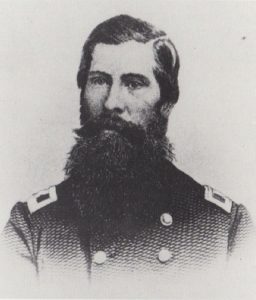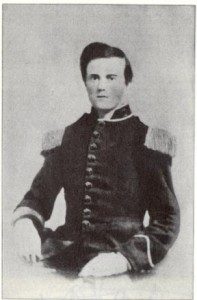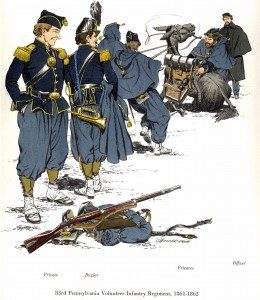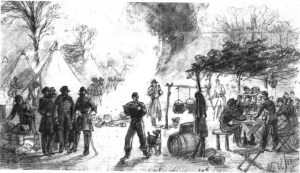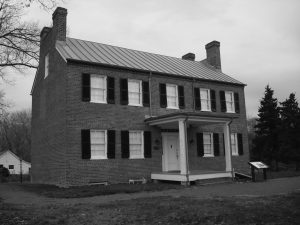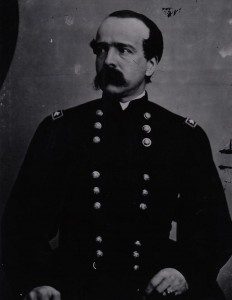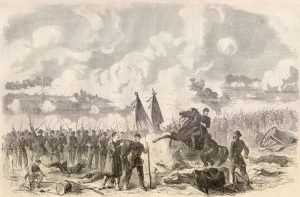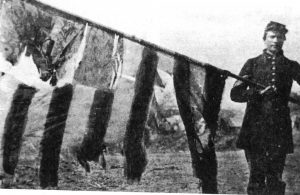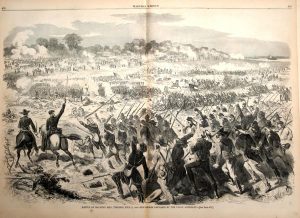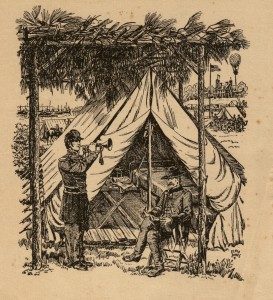One of the Very Best Regiments:
The 83rdRegiment Pennsylvania Volunteers
by George E. Deutsch and Gerald English
The following material is Copyright © 2011 by George Deutsch
During the Civil War, the 83rd Regiment, Pennsylvania Volunteer Infantry (PVI) earned a well-deserved reputation as “One of the very best regiments in the Army.”[i] It fought on virtually all the eastern battlefields and suffered the second-highest battle deaths of any Union regiment. Historian Lt. Col. William Fox described the 83rd as one of the Three Hundred Fighting Regiments: “Blunders caused none of its losses, none occurred in disastrous routs, its dead always lay with their faces to the enemy.”[ii]
Organizing The Regiment
The 83rd PVI was mustered into Federal service in Erie, Pennsylvania, on Sept. 8, 1861, under the command of Colonel John McLane. Like many North and South regiments recruited that first summer of the Civil War, the 83rd’s history began with a pre-war militia unit, the Wayne Guards. General Anthony Wayne was the famous first commander of the U.S. Army who died in Erie on Dec. 15, 1796. The Guards was a large militia company organized by McLane in 185; its ranks were filled with men who would become members of the later regiments from northwestern Pennsylvania, especially the 83rd.
When President Lincoln issued his first call for volunteers, the energetic McLane responded by organizing a three-month regiment officially designated the Erie Regiment. The Wayne Guards formed the first three companies of the new regimen,t with five other companies recruited from Erie County and two from Crawford County. The Erie Regiment, also called “McLane’s,” trained at Camp Wilkens near Pittsburg but was mustered out of the army on Jul. 21, 1861, at the end of its service without seeing any action, missing the Union disaster at the Battle of First Bull Run.
On Jul. 24, McLane received an order from Secretary of War Simon Cameron to raise a new regiment for three years of service. By September, more than 1,000 men had responded to McLane’s call, including about 300 from the Erie Regiment. The ranks were filled with men from recruitment centers in the northwestern Pennsylvania counties of Erie, Crawford, and Forest. The field officers were John W. McLane, Colonel; Strong Vincent, Lt. Colonel; and Dr. Louis H. Naghel, Major. The unit was officially designated the 83rd in the order of its acceptance into Pennsylvania service.
On Sept. 18, the regiment proceeded to Halls Hill, Va., in the Washington, D.C., area, where the troops received their uniforms and were equipped with Harper’s Ferry muskets. It was then assigned to the Third Brigade of General Fitz-John Porter’s Divisio—the organization of the Brigade, commanded by Brig. Gen. Daniel Butterfield included the 12th N.Y., 17th N.Y., 16th Mich, And eventually the 44th N.Y. regiments. Butterfield was a strict disciplinarian and subjected the troops to a firm course of instruction. “Observance of orders was rigidly exacted, and instruction in the manual of arms and bayonet exercise was systematically given. Company and regimental drills were practiced daily, and brigade drills three times a week. The men were held accountable for order and cleanliness by a regular and minute inspection of clothing, arms, and accouterments. The best shots at target firing were publicly acknowledged. The regiment soon became noted for its drill’s excellence and soldierly appearance. On one occasion, [army commander Major] General [George B.] McClellan, in passing along the lines with his staff, rode up to Col. McLan, and said, ‘Colonel, I congratulate you on having one of the very best regiments in the army!’”[iii]
That fall, the army held a competitive trial for drill proficiency. The 83rd was one of two regiments awarded prized imported French uniforms. “It was the uniform of the Chasseur de Vincennes, consisting of a shako, two uniforms,” a cloak, a leather knapsack,k and complete sets of personal and mess gear.[iv] Although the new European uniforms were tiny for the typical American soldier, many men had their photographs taken in their new fancy clothes.
In October, the 44th N.Y. arrived and encamped next to the 83rd. A strong bond of friendship grew between the two regiments. Their regimental histories fondly recite the story of celebrating New Year’s Eve 1861 and their decorated camps, music, dancing, g, and feasting. However, joy was short-lived when the mud and cold of winter quickly set in.
After months of prodding from President Lincoln, McClellan finally began offensive operations against the Confederate Army encamped nearby around Centerville and Manassas, Virginia. “On the morning of Mar. 9 [1862], the regiment received orders to be ready to move on the following morning. The whole grand army, which for six months had been encamped in front of Washington, was [ordered] to advance upon the enemy”[v] The French uniforms, impractical for field us,e were sent away. “On the morning of the 10th… the regiment commenced its first march –a prelude to four lon,g eventful years of warfare – and arrived at Fairfax Court Hous in the evening. Here it ascertained that the enemy had abandoned his entrenched ca and had retreated.”[vi]
Blenheim House, around which the regiment camped that night, is now owned by Fairfax. However, its attic walls still contain graffiti and many signatures left by the soldiers of the 83rd.
The Peninsula Campaign
George McClellan, the North’s “LittleNapoleono,n” next decided to advance on his strategic target, the Confederate capital at Richmond, Va., through the indirect approach. Most of the Army of the Potomac was ferried to the Virginia peninsula, formed between the York and James Rivers. The 83rd embarked at Alexandria and landed on Mar. 24 at Hampton. “On the 4th of April,l it joined the advance on Yorktown…Around the town was a bastioned Ford with over 70 heavy artillery guns.”[vii] Rather than attempt an immediate direct assault on the formidable-looking but weakly held the line, General McClellan began siege operations Armedd with picks and spades, Porter’s commands dug rifle pits which “were widened and deepened until they were finally formed into covered ways, in which were constructed regular batteries, with embrasures for the heavy ordinance. Among the works were 14 batteries, mounting from six to 16 guns…At length, on May 3, when the works were all finished and the guns in position, ready to make the grand assault, the [Confederates,] under cover of a heavy cannonade, retired from they’rer] fortification and retired up the Peninsula.”[viii]
McClellan reorganized the army in the field; on May 18, he gave his close friend Porter the command of the newly created Fifth Army Corps. The 83rd was now part of the Third Brigade (Butterfield’s), First Division (Morell’s), and Fifth Corps (Porter’s) and would remain in that designation until the end of the war.
As the Confederates retreated, the 83rd moved on transports up the York River with the rest of Porter’s Corps, eventually forming the right flank of the Union Ar, northeast of Richmond. As the opposing armies jockeyed for position just outside the city’ssgatesy, McClellan ordered Porter, newly promoted to major general, farther north to Hanover Court Hous,e where one or more Confederate brigades were reported. On May 27, after a severe rain-soaked march, the regiment was baptized into combat. McLane’s soldiers first came under artillery fire while leading the brigade’sadvance towards the Court House against weak opposition, overrunning a prized Confederate cannon, which the 17th New York later claimed after the 83rd had moved on. Butterfield then ordered a countermarch against a new threat to the rear. After a sharp engagement near dusk, the Confederates abandoned the field.[ix] That day, the 83rd captured over 100 of the enemy while suffering eight wounded men, one who later died, and two missing out of 300 Union casualties. Writing 83rd in his report, Butterfield stated: “They behaved on every occasion like veterans.”[x] The next day,y as they buried many dead on the battlefield, thenow-bloodedd boys from northwestern Pennsylvania saw the true horrors of war.[xi] When the Corps began its march back towards the main army, a large number of freedom-seeking “contrabands” enslaved peoples) returned with the 83rd to camp, many becoming paid servants, cooks, laborers, teamsters,s and laundresses for the officers and regiment. Some men would later join “Colored” combat units to fight for their freedom.[xii]
After being pulled back from Hanover, Porter Corpsremainedson the right flank of the Army of the Potomac. Consequently, the 83rd was not engaged in the Battle of Fair Oaks/ Seven Pines, which fought south of the Chickahominy River on May 31 and Jun. 1. That battle. However, a draw had meaningful consequences due to the wounding of the Confederate commander, Joseph E. Johnston, whose replacement was General Robert E. Lee.
McClellan’s slow preparations for besieging Richmond allowed the aggressive Leey to strike first at the end of June in what would become known as the Seven Days Battles. The Chickahominy is a small river bordered by dense swamps, making it passable only at bridges. It runs from northwest of Richmond and then curves to the south and east. After Fair Oaks, McClellan had massed his army south of the Chickahominy except for Porter’s Corps, leaving it to shield the supply base on the York River. Lee devised a plan to concentrate most of his army, about 60,000 men, including the newly arrived troops of Maj. Gen. Thomas J. “Stonewall” Jackson, north of the Chickahominy against Porter’s isolated 27,000 soldiers, in the hopes of crushing that portion of the Union army and then driving McClellan away from Richmond.
The action opened on Jun. 26 when Porter repulsed the Confederate attack along Beaver Dam Creek. The 83rd was not involved in that action. That night Porter withdrew to an even more formidable position near Gaines’s Mill. The Corps was drawn up on the high eastern bank of Boatswain’s Swam,p with Butterfield’s Brigade holding the left flank, closest to the Chickahominy. The 44th N.Y. stood on the extreme left,t with the 83rd on its right. This would be the first time these two regiments would fight side by side, a position they would adopt in nearly every battle over the next three years. The friendship born in the first winter camp and further forged by the fire of ware earned the two regiments the nickname “The Butterfield Twins.” To the rear of the Twins were supporting artillery with the 16th Mich. and the 12th N.Y. inreservevbothh the 83rd and 44th constructed log breastworks to enhance their position further.
Lee’s plan to pin Porter’s Corps frontally while sending Jackson’s divisions around to assault Porter’s right flank and rear fell apart when Jackson failed to arrive on the field. The battle instead devolved into a series of bloody frontal assaults begun by Maj. Gen. A.P. Hill’sdivision attacked Morell’s division’s tablet units, later joined by Ma—Ge. Finally, James Longstreet’s division made repeated attacks on the 83rd and 44th.
Samuel Bates, Pennsylvania’s official historian of the war, wrote of the battle:
Under cover of heavy artillery fire, Longstreet’s infantry advanced,d driving in the skirmishers. When in full view, awell-directedd volleyfrom the front and rear lines of the 83r, andrapid-firee from the batteries abovi, checked hi, for instance, but closed up the gaping rents in his line, he rallied and pressed forward. His color-bearer in front was repeatedly shot down, but the standard was as often caught up, and bravely di,d hisstruggledruggle to push on. But vain were the attempts to facfirestormstormt, and it fell back in confusion. Rallying with fresh troops, he advanceddvance and was again repulsed. In desperation, for a timed time,e he pushed forward the attack but was in router outlet, not again to appear over the brat killerillerl hill.[xiii]
Throughout those assaults, Col. McLane stood near the center of the regimen,t encouraging and inspiring the men to hold their ground.
As the afternoon wore into evening, Jackson’s forces finally arrived at Obattlefieldlefiel. Still,continuedinuedd the frontal assaults on Porrights right instead of sweeping to the rear as Lee had planned. Unfortunately for Porter, McClellan supported his stout defense with witreinforcementscement,s and those only late in the day. Porter’s command had suffered many losses in repulsing the earlier attacks and had few reserves to call on. Sometime after 7:30 p.m., off to the right of the 83rd, Chase Whiting’s crack Confederate division, which included John B. Hood’s TexasBrigadee and Evander Law’s Alabamians, finally broke through Morell’s line and the troopsroopss of John Martindale and Charles Griffin. The Confederates poured through the gap. Woods them was s and not initially observed by Butterfield’s men until they emerged on the right flank and rear of the Brigade.
Bates continued:
Quickly changing front, [the 83rd] faced to the north, at the right angles to the first line of battle, to meet the threatened danger. It was hardly in position before it was attacked. In the previous encounter, protected by breastworks, its loss had been trifling, while the enemy’s lines had been shattered. But now, forced into line in the open while toilette wood sheltereenemyenImyd, I,t was subjected to the fiery ordeal. Nevertheless, it stood firm. Here Col. McLane fell dead, pierced by a bullet [in the hearing in a moment more,e Major Naghel dropped, struck shell fragment shell, receiving a mortal wound expiring the following day. In the absence of Lt. Col. Vincent, prostrated by fever, the command developed on Captain Hugh CampThrough exposure sure to a fearful musketry fire, the line did not waver, and the enemy was driven from its front. It was soon evident, however, that he was past pas and gaining its rear. The regiment again changed front, marching proper flank flan and forming a line parallel to that held imorningmornin, but facing in the oppdirectionrectio and to the east[xiv]
During this crisis, after McLane had fallen, Dan Butterfield “Seized the colors of the 83d Pennsylvania Volunteers at a critical moment and, under a galling fire of the enemy, encouraged the depleted ranks to renewed exertion.” In 1892, he was awarded the Medal of Honor for this action.[xv]
“It was now evident thabrigade’s three regimentsrigade, the 44th N.Y., the 16t, Mich, and th was, were entirely cut off from the main body of the armysurroundedoundes, except the passage towards the river.”[xvi] At this point, “the enemy sent forward a flag of truce with an unsuccessful demand for its surrender.”[xvii] Lt. Plimpton White of Company D was ordered to go out to determine the identity of the approaching troops. He had a white handkerchief attached to his sword that he held high. An officer asked if he had come to surrender. White responded, “Who are you?” The reply was, “The 11th South Carolina,” to which White shouted, “The 83rd Pennsylvania never surrenders to South Carolinians.” Then, the enemy officer demanded, “What do you want?” White responded, “I have come to demand that you surrender unconditionally.” After parting, White heard Confederate muskets cock; he fell to the ground as their volley passed overhead. The 83rd, thinking he was shot down under a fltrucef truc,e was infuriated. They returned the volley into the Confederate rank,s and the battle raged on. White survived that day only to be wounded at Malvern Hil five days later.[xIt is]
The Brigade was facing imminent destruction. “The word was accordingly given to break and seek the river. The open flats of the Chickahominy, which intervened, were raked by heavy artillery fire, and many were struck down attempting to reach the stream. The regiment went into action five hundred and fifty strong. Of them,e two hundred and sixty-five were either killed, wounded,d or taken prisoners.”[xix]
Shortly after the war, a party from Erie, including Col. McLane’s wide,w visited the field. There they encountered a man named Magee, whose father owned the land upon which the 83rd had fought. He had been a member of Pickett’s Brigade under Longstreet. He said,m “Several charges on your left had been made when we were ordered in. It was the worst place I ever saw. We went I,n but came out in a hurry and didn’t want to return. We then charged that battery that swept our approach to your left,t and we took it. I fought through the war… and I never saw your men fight as Butterfield’s Brigade did that day, excepting on the center the last day of Gettysburg.”[xx]
Praise for the 83rd also came from the historian of the other Twin, who wrote: “The 83rd Pa., which held a position in the front line of battle to the right of the 44th, occupied the position of greater danger and sustained itself most credibly under most trying circumstances. Its loss was heavy, but its brilliant record was unsurpassed on that field.”[xxi]
Amos Judson, who was an officer in the 83rd until September 1864, wrote of Gaines’s Mills:
Although the battle resulted disastrously to our arms, the polite behavior of the 83rd upon that day covered them with glory; for never, in my opinion, did men fight with more obstinacy and acquit themselves with more honor. And I also wish to bear testimony to the gallant conduct of the other two regiments of the Third Brigade upon that occasion, the 44th N.Y. and 16th Mich. Out of all the regiments of Porter’s Corps, these three…although they fought alone and against hope, they fought until darkness. The enemy, in overwhelming numbers, had closed around them.[xxii]
That night Porter crossed the Chickahominy downstream with the rest of his command. The 83rd and the other regiments rejoined the Corps the next day. McClellan’s army began to retreat southeast towards the James River, with the V Corps in advance. The company took no part in the battles on June 28th or 29th.
On Monday afternoon,n Jun. 30, McClellan reviewed the army. Shortly after the review ended, Confederate artillery bombarded the V Corps guns under Griffin, and the 83rd was moved to a supporting position. The Union artillery out-dueled their opponent’s guns, who then withdrew.”[xxiii]
On the night of the 30th, for the first time during the Seven Days, the entire Union army was united. They stood on Malvern Hill, a broad open plateau, the front strongly posted with artillery batteries closely supported by infantry. Porter’s Corps held the left of the line.
The next day, Jul. 1, Lee attacked the Malvern Hill position. For the first two hours of the battle, the 83rd endured heavy artillery fire. It then hurried to the front line to closely support a battery in danger of being captured. For the next two hours,s the regiment stood exposed to a murderous fire. “With great gallantry and courage,e the line was maintained, and the battery, which had been on the point of moving to the rear, unlimbered and poured into the enemy’s massed lines grape and canister until the ammunition failed when the gunners cut the chains from their horses’ harnesses and hurled them at the foe.[xxiv]
Late in the day, “the 44th N.Y. and the 83rd Pa. united in a gallant charge under the eye of the corps commander, driving the enemy and capturing a battle Flagg.”[xxv] That da,y the 83rd lost “about forty killed, and one hundred and ten wounded, of whom a number afterward died. Among the [eight officers wounded] was Captain Campbell, in command of the regiment.”[xxvi]
Malvern Hill was a clear victory for the Union army. Although the Yankees took heavy losses, the Confederates suffered much more severely. Their series of uncoordinated brigade-sized assaults were each cut to pieces in turn.
That night Porter repeatedly proposed a counter-offensive “‘urging McClellan to move forward on Richmond at daylight.’ General McClellan, however, had long since made up his mind. His only thought was haven at Harrison’s Landing [10 miles further downstream on the James River]. Without even waiting for Porter’s verdict on the day’s events, contradicting all of Porter’s later arguments, he ordered the army to continue to retreat.”[xxvii]
“On arriving at Harrison’s Landing [the 83rd] stacked about 80 muskets. On the evening of Jul. 4, an election to fill the vacancies occasioned by the deaths of Col. McLane and Major Naghel was held at which Lt. Col. Vincent was chosen Colonel; Captain Campbell, Lt. Col.; and Adjutant William Lamont, Major.”[xxviii] During the intervening week,s while camped at Harrison’s Landing (today’s Berkley Plantation,) Butterfield, who had already established special bugle calls exclusive to his Brigade, called in his bugler, Private Oliver Willcox Norton of the 83rd and on a hot summer evening, they produced a tattoo which would become the most famous bugle call of all, Taps.
George Deutsch, Author
Historian and autho, George Deutsch co-founded several historical organizations related to the Civil War and the War of 1812 in his hometown of Erie, Pa. One of them isg the Flagship Niagara League, the non-profit which championed the reconstruction of the U.S. Brig Niagara. He has also published multiple articles on the Civil War era’s 83rd Pennsylvania Volunteer Infantry Regiment and Commodore Oliver H. Perry’s Niagara, which played a critical role in the 1813 Battle of Lake Erie.
Deutsch annually teaches history courses at the Chautauqua Institution in New York and has led dozens of battlefield tours for Civil War roundtable and university groups. He has been honored twice by the Pa. Historical and Museum Commission and received the Local History Award in 2003 from the Erie County Historical Society.
Deutsch helped to lead the Niagara League for nearly two decades, including during the construction of the Erie Maritime Museum. He has also been involved in multiplehistoricl preservation projects. He designed the wayside marker about Strong Vincent and Joshua Chamberlain on Gettysburg’s Little Round Top, led the effort to restore Erie County’s Civil War monumen,t and worked to erect Vincent’s statue in Erie. He also helped to lead the conservation of the 83rd and 145thPennsylvanias battle flag,s now preserved in the Erie County Library.
He was educated at Georgetown University’s School of Foreign Service and Mercyhurst College, where he earned a degree in history. He is writing, with a partner, a new book on the 83rd Pennsylvania, focusing on the untold history of its last year in the war. He now lives in Catonsville, Md., with his wife, Mary Fran.
[i] Amos M. Judson, History of the Eighty-third Regiment Pennsylvania Volunteers (Dayton: Morningside, 1986), 22.A quotee attributed to Union army commander Maj. Gen. George B. McClellan in 1862.
[ii] William F. Fox, Regimental Losses in the American Civil War: 1861-1865 (Albany: Albany Publishing Co., 1889), 282.
[iii] Samuel P. Bates, History of Pennsylvania Volunteers, 1861-1865 Vol. 2 (Harrisburg: B. Singerly, 1869), 1248-9.
[iv] Bates, History of Pa. Volunteers, 1249.
[v] Bates, History of Pa. Volunteers, 1249.
[vi] Bates, History of Pa. Volunteers, 1249.
[vii] Bates, History of Pa. Volunteers, 1249-50.
[viii] Bates, History of Pa. Volunteers, 1250.
[ix] Michael C. Hardy, The Battle of Hanover Court House (Jefferson, NC: McFarland & Co., Inc. Publishers, 2006), 60-63, Judson, History of the 83rd, 49.
[x] Judson, History of the 83rd, 52.
[xi] Oliver Wilcox Norton, Army Letters, 1861-1865, (Dayton, OH: Morningside Books, 1990), 82-85.
[xii] Judson, history of the 83rd, 52.
[xiii] Bates, History of Pa. Volunteers. 1250.
[xiv] Bates, History of Pa. Volunteers, 1251.
[xv] Medal of Honor Citation
[xvi] Bates, History of Pa. Volunteers, 1251.
[xvii] William H. Powell, The Fifth Army Corps (Army of the Potomac) A Record of Operations (Dayton: Morningside, 1984), 113. Powell’s book wasinitiallyy published in 1895.
[xviii] Judson, History of the 83rd, 66.
[xix] Bates, History of Pa. Volunteers, 1251.
[xx] Isaac Moorehead, The Occasional Writings of Isaac Moorehead (Erie, PA: A.H. Caughey, 1882), 150.
[xxi] Eugene A. Nash, A History of the Forty-fourth Regiment New York Volunteer Infantry (Dayton: Morningside, 1998), 84.
[xxii] Judson, History of the 83rd, 55.
[xxiii] Bates, History of Pa. Volunteers, 1251.
[xxiv] Bates, History of Pa. Volunteers, 1252.
[xxv] Powell, The Fifth Army Corps, 168.
[xxvi] Bates, History of Pa. Volunteers, 1252.
[xxvii] Stephen W. Sears, To the Gates of Richmond, The Peninsula Campaign (New York: Ticknor and Fields, 1992), 336.
[xxviii] Bates, History of Pa. Volunteers, 1252.
This entry was posted on Monday, November 21, 201,1 at 8:16 pm and filed under Uncategorized. You can follow any responses to this entry through the RSS 2.0 feed. Unfortunately, answers are closed, but you can track back from your site.

